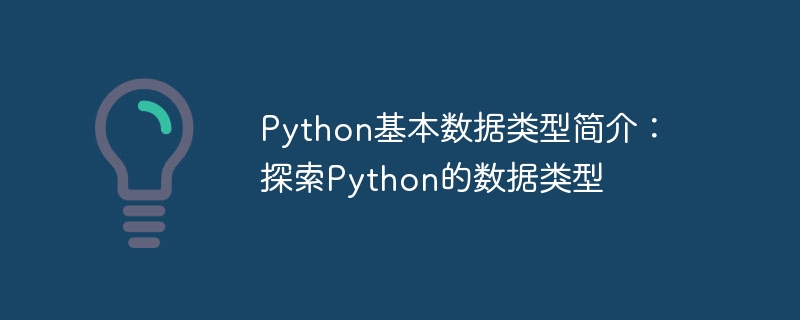Home >Backend Development >Python Tutorial >Python Data Types Overview: An in-depth look at Python's data types
Python Data Types Overview: An in-depth look at Python's data types
- 王林Original
- 2024-01-20 09:28:16660browse

Introduction to Python’s basic data types: To explore Python’s data types, specific code examples are required
Python is a high-level programming language that provides a rich set of data types. Makes it easier for programmers to process various data. In this article, we will explore several basic data types in Python and provide code examples to illustrate their use.
- Integer (int)
Integer is one of the most commonly used data types in Python. It is used to represent integer values, which can be positive, negative, or zero. In Python, integers have no size limit and can handle arbitrarily large integers.
Sample code:
a = 10 b = -5 print(a) # 输出:10 print(b) # 输出:-5
- Floating point number (float)
Floating point number is used to represent numbers with a decimal point. It can be positive, negative, or zero. In Python, the precision of floating point numbers is limited, so you need to pay attention to error issues when performing floating point number operations.
Sample code:
a = 3.14 b = -2.5 print(a) # 输出:3.14 print(b) # 输出:-2.5
- String (str)
A string is a sequence of characters used to represent text. In Python, strings can be enclosed in single or double quotes. Strings are immutable, that is, existing strings cannot be modified directly, but new strings can be generated through operations.
Sample code:
a = "Hello" b = 'World' print(a) # 输出:Hello print(b) # 输出:World
- Boolean value (bool)
Boolean value is a data type that represents true and false, with only two possible values. : True and False. In Python, Boolean values are commonly used in conditional statements and loop control.
Sample code:
a = True b = False print(a) # 输出:True print(b) # 输出:False
- List (list)
A list is an ordered collection of elements. Lists can contain different types of data and can be dynamically adjusted as needed. Lists are mutable and elements can be accessed and modified via index.
Sample code:
a = [1, 2, 3, 4, 5] b = ['apple', 'banana', 'orange'] print(a) # 输出:[1, 2, 3, 4, 5] print(b) # 输出:['apple', 'banana', 'orange']
- Tuple (tuple)
A tuple is an ordered collection of elements, similar to a list. Unlike lists, tuples are immutable, i.e. elements cannot be modified and added. Tuples are often used to store immutable data.
Sample code:
a = (1, 2, 3, 4, 5)
b = ('apple', 'banana', 'orange')
print(a) # 输出:(1, 2, 3, 4, 5)
print(b) # 输出:('apple', 'banana', 'orange')- Dictionary (dict)
A dictionary is an unordered collection of key-value pairs. Each key-value pair forms an item, and the corresponding value can be accessed through the key. Dictionaries are mutable, items can be added, removed, and modified.
Sample code:
a = {'name': 'John', 'age': 18, 'country': 'USA'}
print(a) # 输出:{'name': 'John', 'age': 18, 'country': 'USA'}The above is an introduction to several basic data types commonly used in Python. Each type has its own characteristics and uses. By understanding basic data types, we can better write Python programs and handle various complex data operations.
Summary: Python’s basic data types include integers, floating point numbers, strings, Boolean values, lists, tuples and dictionaries. Each type has its own characteristics and usage, and by using them flexibly, various data can be easily processed. The above is just a brief introduction to these data types, and there are many advanced features and uses that can be further explored. When actually writing a program, please choose the appropriate data type according to specific needs to achieve more efficient and reliable development results.
The above is the detailed content of Python Data Types Overview: An in-depth look at Python's data types. For more information, please follow other related articles on the PHP Chinese website!
Related articles
See more- Detailed explanation of the difference between JavaScript basic data types and reference types
- What are the specific data types of js and the basic data types of JS?
- What are the basic data types in Java
- Detailed analysis of the six basic data types in JavaScript
- Let's talk about several common basic data types in Golang

